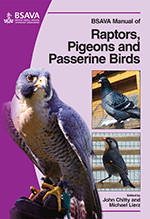
Full text loading...

Injuries to the skin often result in large hard subcutaneous abscesses on the dorsal aspect of the foot on raptors. Staphylococcus spp. are the bacteria most commonly isolated from these lesions. In this chapter disorders of the feet are presented and discussed in alphabetical order.
Raptors: disorders of the feet, Page 1 of 1
< Previous page | Next page > /docserver/preview/fulltext/10.22233/9781910443101/9781910443101.16-1.gif

Full text loading...



















